The Unhealthiest Steak Cuts You Can Buy
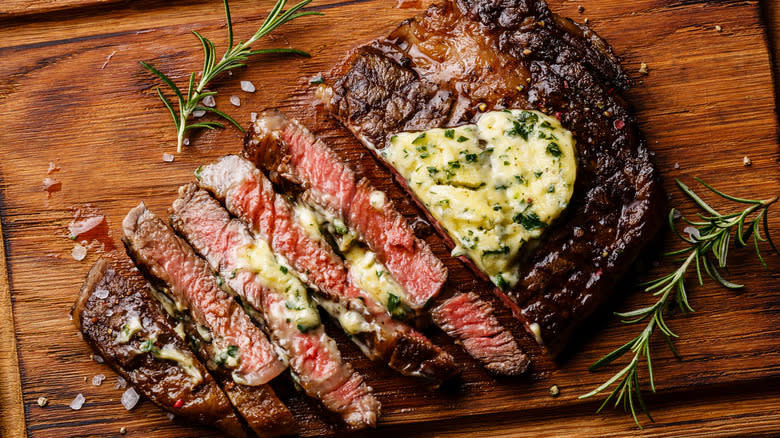
Steak is a great source of protein, iron, and many other vitamins and minerals. However, the nutritional benefits of steak can easily be outweighed by its unhealthy elements. It doesn't take a genius to see the recurring theme in the unhealthiest cuts of meat: they are all particularly high in fat, saturated fat, and cholesterol. Consuming large quantities of these can increase the risk of cardiovascular diseases such as heart disease and stroke, as well as contribute to weight gain and other health issues. But some cuts of beef are healthier than others, so it's useful to know the nutrition information when deciding on both the type and amount of steak to eat.
That's why we've put together this list — to help you understand the health factors of various cuts of steak when choosing one at a restaurant or grocery store. Yes, some cuts are noteworthy for their poor overall health profiles, but this doesn't mean you need to eliminate them from your diet entirely. The key is always moderation. Armed with nutrition facts, you'll find it easier to make steak choices that support your overall well-being, including opting for leaner cuts over more fattier ones, especially if you find yourself consistently eating lots of steak.
Read more: Cuts Of Steak, Ranked Worst To Best
Ribeye
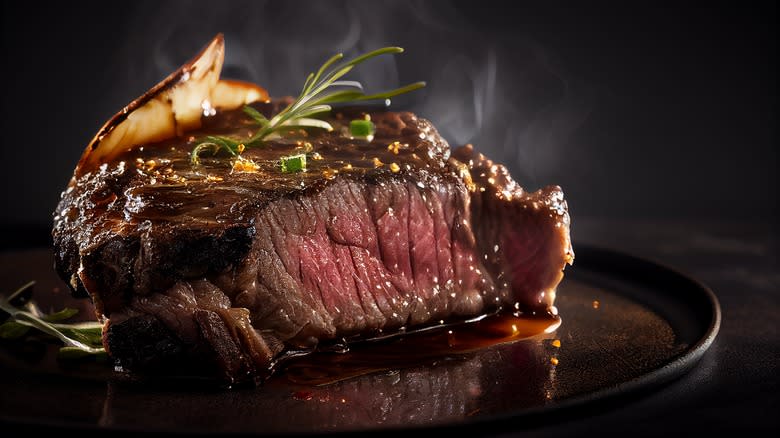
Many steak-lovers simply cannot resist the juicy tenderness of a ribeye. Unfortunately, it's one of the least healthy steak cuts out there. This makes sense given that it's the fattiest muscle in the whole cow. Because the fats are so evenly dispersed throughout the meat, it's impossible to cut it out, not that anyone who's eating a ribeye would want to.
Looking into the nutrition information for ribeye, the concentrations of fat, saturated fat, and cholesterol are notably high. In a 3-ounce serving, you're looking at 16 grams of fat (7 of which are saturated fat), and 66 milligrams of cholesterol. To put this in perspective, based on a recommended 2,000-calorie daily diet, that's 21% of your daily fat, 36% of your saturated fat, and 22% of your cholesterol intake. This might not seem too bad, but it would be irresponsible not to consider the typical ribeye portion sizes. It's common for a person to eat anywhere from 6 ounces to 16 ounces (a whole pound) in a single meal. So, if you eat a 10-ounce portion of ribeye, here's what you're consuming: 68% of the daily recommended fat intake, 120% of the daily recommended saturated fat intake, and 73% of the daily recommended cholesterol intake. And this is without adding butter, sauce, or sides. Again, we're not saying you should never eat a big, juicy piece of ribeye, but for the sake of your health, it's best to do so sparingly.
Prime Rib
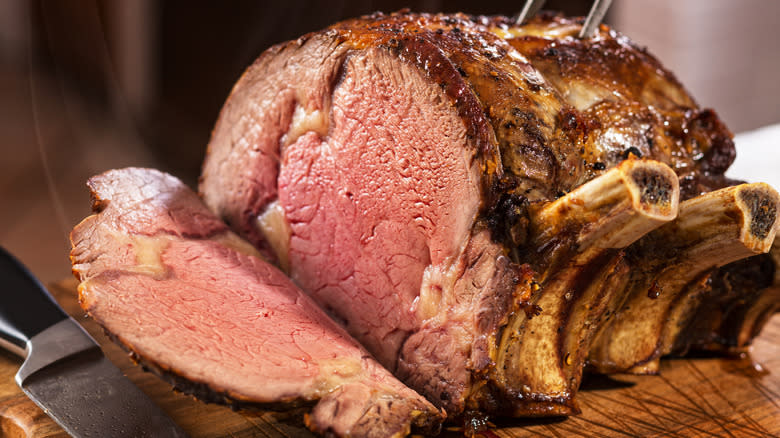
Prime rib and ribeye have lots in common, though they are not exactly the same. While both come from the primal rib section of the cow, the way a butcher cuts and prepares prime rib versus ribeye marks the difference between them. Ribeyes are cut into individual steaks. Prime rib is the larger roast cut, usually cooked with the bone still attached. Unfortunately, because their differences are few, it means that just like the ribeye cut, prime rib is on the far unhealthy end of the steak scale.
Specifically, let's look at prime rib's saturated fat and cholesterol content. A 3-ounce portion of prime rib has about 9 grams of saturated fat and 71 milligrams of cholesterol. This is remarkably high, at 47% and 24% of the FDA's daily recommended consumption of saturated fat and cholesterol, respectively. Similar to eating ribeye, people don't usually limit themselves to 3 ounces. The culture of this famously juicy cut is that a chef slices off a serving of 12 or even 16 ounces. All you have to do is multiply the nutrition values by four or more to realize that eating such a large portion of prime rib can be unhealthy. On top of that, the most common way to eat prime rib is rare or medium rare. Consuming undercooked meat carries a risk of foodborne illness like E. coli, adding even more potential health risks to this cut.
Porterhouse

The porterhouse is a bone-in steak that encompasses two main cuts. On the long side of the bone is a strip steak, and on the short side of the bone is the tenderloin. This gives it an amazingly versatile flavor experience. You'll get the rich, robust taste of the strip steak. Then, on the other side of the bone, you'll taste the perfect complement with the tenderloin's buttery texture. Often known as the ultimate luxury in the world of steaks, the porterhouse is almost always served in a large portion of around 16 ounces. This is great news for your tastebuds but certainly not the best for your health.
A 16-ounce serving of the porterhouse cut has nearly 1,000 calories, 65% of the FDA's daily recommended fat intake, 90% of the daily recommended saturated fat, and 94% of the daily recommended cholesterol. In other words, porterhouse steaks are a heart health nightmare. Understandably, a true steak-lover won't be able to resist eating one every so often, all nutrition matters aside. Still, you might consider splitting it with someone to reduce the impact. That way, you'll get to delight in its irresistible flavor without having to think so much about the potential cost to your health.
T-bone
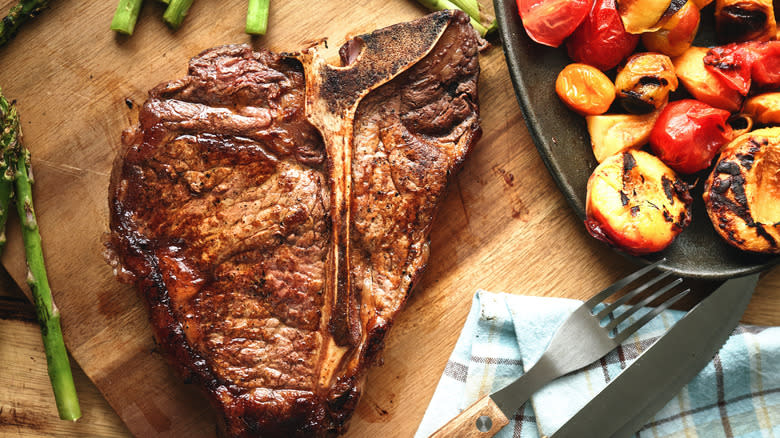
The T-bone steak gets its name from its appearance. If you look at the structure of this well-known cut, you'll see a bone in the shape of a "T" right down the middle, dividing the tenderloin on the short side from the strip steak on the long side. The T-bone is a close cousin to the porterhouse, which also has that eye-catching bone down its center. The difference between the two is only size, regulated by the U.S. Department of Agriculture. According to its Institutional Meat Purchase Specifications, the tenderloin of a porterhouse has to be at least 1.25 inches thick. For a T-bone, it only has to be 0.5 inches thick.
Following logic, it makes sense then that the T-bone cut is only slightly healthier than the shockingly unhealthy porterhouse because you typically eat less of it. A standard serving of T-bone steak is around 8 to 12 ounces. Even if you were to choose the relatively smaller 8-ounce portion, the nutrition facts are still abysmal. With 58% of what the FDA recommends daily for fat, 95% of its daily recommendation for saturated fat, and 63% of its daily recommendation for cholesterol, this is surely not a steak cut you should be eating all that often.
New York Strip
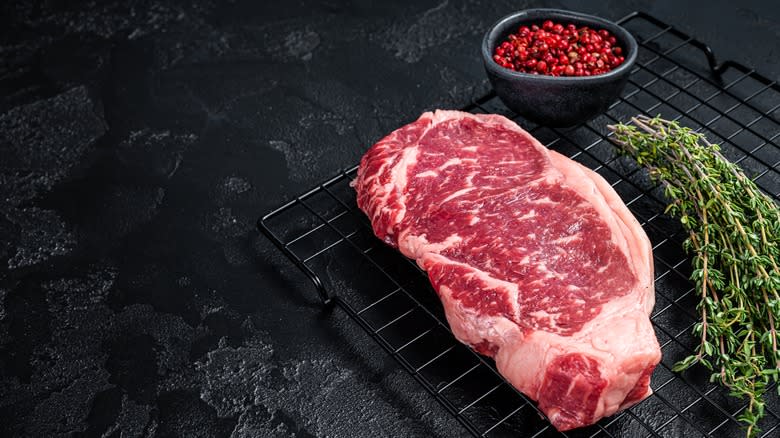
The New York strip is usually a bone-in cut of beef with a significant fat cap that runs along one side of the bone. This fat helps give the New York strip such a delicious flavor. The cut comes from the shorter loin section of the cow with lots of marbling (also known as distribution of fat) throughout. This is another reason it's such a tender and tasty cut. However, all that fat is not good for you, especially considering the cut is ideally 2 inches thick, making its typical serving size around 10 to 12 ounces.
A 10-ounce New York strip has a whopping 25 grams of saturated fat per serving, or 127% of what the FDA says you should be eating daily on a 2,000-calorie diet. Alongside the hefty dose of saturated fat, it also has 81% of the overall fat the FDA recommends per day, and 74% of the cholesterol. For a slightly less fatty version of the New York strip, you can try to find an option without the bone, though because of all the marbling in the meat, the difference isn't all that significant. Whether or not you're particularly health-conscious, this is not a cut of meat meant to be eaten daily or maybe even monthly.
Chuck Eye
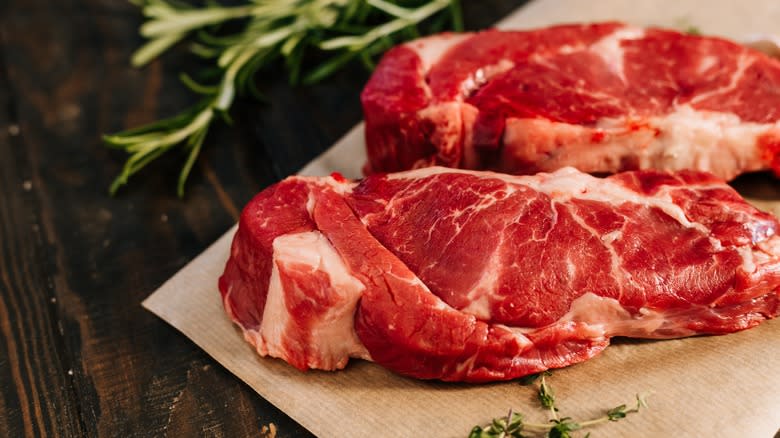
The chuck eye cut of steak, which also goes by a fancier name, the Delmonico, comes from the shoulder region of the cow, not all that far from the ribeye cut. The chuck eye is different from the more general chuck cut, as it comes from the cow's fifth rib rather than further up the neck. This makes it more tender than other chuck cuts but slightly less tender than the ribeye. Many people commonly refer to it as the poor man's ribeye for being fairly similar in taste and texture to the ribeye but costing notably less per ounce. And like the ribeye, it's also not very healthy, with lots of fat, saturated fat, and cholesterol.
It's easier to find chuck eye cuts in smaller portions than many of the other steaks on this list, something that helps it a bit in the health department. In a 6-ounce serving, which is common in grocery stores and restaurants, a piece of chuck eye contains 44% of what the FDA recommends eating daily for overall fat, 74% saturated fat, and 49% cholesterol. The fat and cholesterol content, while still high, are somewhat justifiable to eat during a single meal, especially compared to the other high-fat cuts on this list.
Picanha
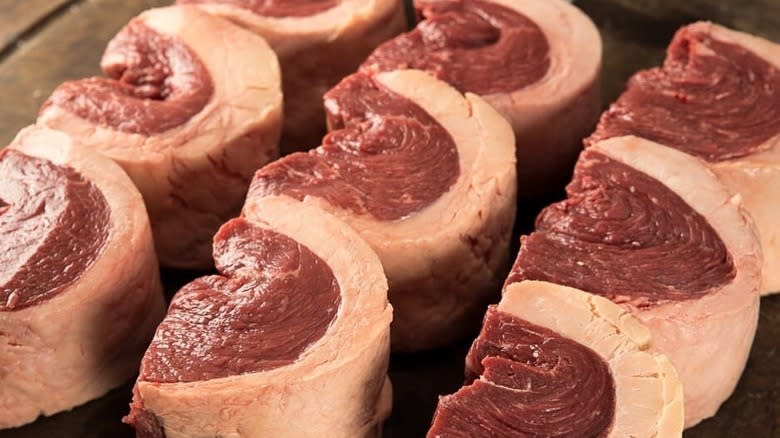
The picanha cut isn't well-known yet in the U.S. and Europe, though it is gaining momentum. But other parts of the world have known about this cut for ages. It has been one of the most popular steak cuts throughout Latin America for quite some time. In Brazil, picanha is considered one of the highest-end steak cuts you can get, and the country is often credited for its rise to fame. The picanha cut comes from the rump or sirloin cap. The area has little muscle and lots of fat, making it tender and juicy, but also not exactly the epitome of health.
For steak on the unhealthier side, picanha doesn't have the worst health profile around, though it's still up there. A typical 5-ounce piece of picanha has around 43% of the daily recommended saturated fat intake and 45% of the daily recommended cholesterol intake. Considering that this cut is not all that easy to find in U.S. grocery stores, it's probably better left for eating when you visit a fancy Brazilian steakhouse.
Flat Iron
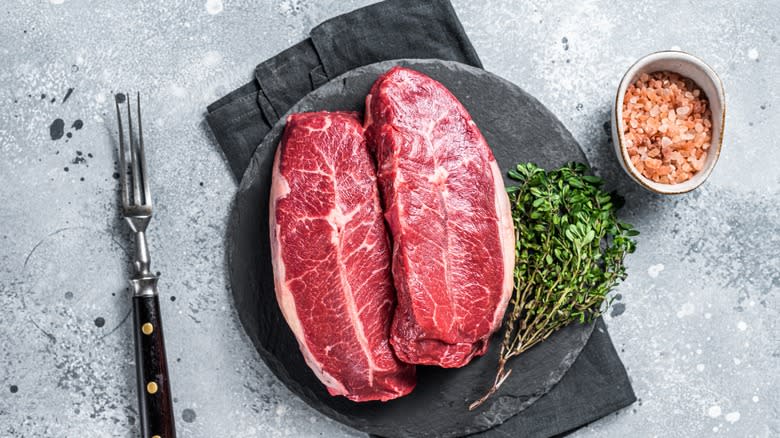
Flat iron steak comes from a muscular "chuck" part of the cow's shoulder. All this muscle makes it a marbled and tender cut that is highly flavorful but not the healthiest. When laid out, its shape is reminiscent of an old-style metal flat iron, hence earning the name. It's not quite as high in fat and saturated fat as some of the others on the list, but it's still far from being considered a lean cut of beef.
One 6-ounce cut of flat iron steak has over 22 grams of fat and about 9 grams of saturated fat, which is respectively 28% and 43% of the daily recommended value. The cholesterol levels in the flat iron cut are high as well, at 142 grams or 47% of what you're supposed to consume daily. Luckily, because flat iron is commonly served in dishes like tacos or fajitas, it's pretty easy to eat much less than a 6-ounce portion to keep the negative health impact to a minimum.
Flap Steak
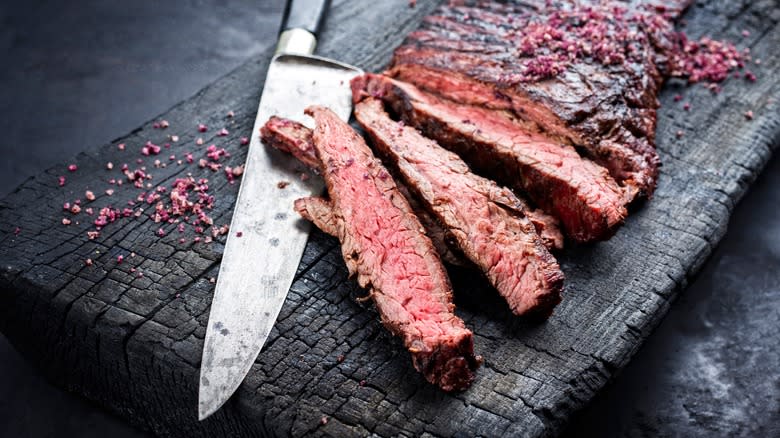
Flap steak comes from the cow's mid-rear section, a region known for its muscle density. It's popular for use in tacos and stir fry because, if not cooked just right, it can easily become tough and chewy. However, when it's cooked either too rare over high heat or very slowly, the muscles become more tender. This allows it to be enjoyed as a traditional steak, especially when sliced thin. While undercooking flap steak can enhance its tenderness, it also increases the risk of foodborne illnesses such as E. coli and Salmonella. This indirect health concern isn't the only factor contributing to its reputation as one of the unhealthiest steak cuts available, either.
Flap steak is also high in fat and saturated fat compared to many leaner steak cuts like eye of round or top round. For example, it has 49% of the daily recommended saturated fat in a 6-ounce serving, whereas eye of round only has 14% in the same serving size. Interestingly, flap steak's cholesterol level is slightly lower than many other unhealthy steak cuts, with only 39% of the daily recommended value in a 6-ounce serving. This isn't "low" by any means, but it is low for a higher-fat steak.
Fliet Mignon
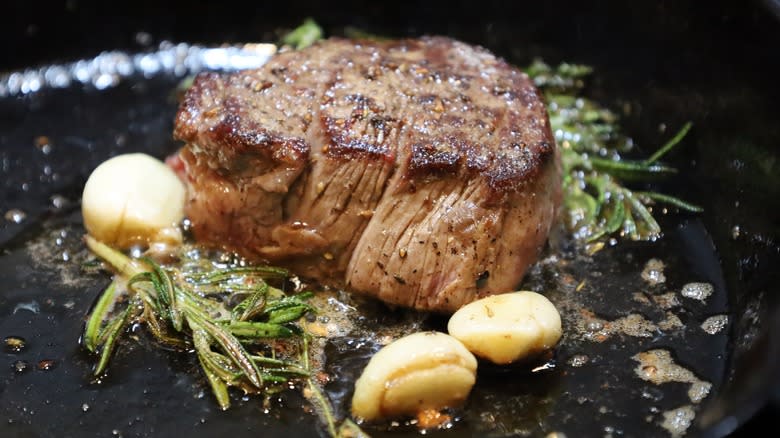
From the cow's backbone, you'll find the notoriously yummy filet mignon, cut from the smaller side of the tenderloin. It is widely known for being a thick, tender, and juicy piece of meat, not to mention among the most expensive on the market. Most steak aficionados will agree that the price tends to be worth it for such ideal flavor and texture. A common misconception that goes around is that filet mignon is a lean cut of steak, but the truth is another story. Sure, compared to ribeye or New York strip steak, filet mignon is not nearly as unhealthy, but it's still fairly high in fat, especially in saturated fat, and cholesterol. Also, people tend to eat it in smaller portions of around 6 to 8 ounces, reducing its negative health impact per sitting.
A 6-ounce piece of filet mignon has 38% of the recommended daily fat intake, 57% of the daily recommended saturated fat intake, and 55% of the daily recommended cholesterol intake. These are not great percentages for anyone conscious of how the food they eat affects their health. On top of that, despite being a bit lower in fat and cholesterol than some of the unhealthiest cuts, filet mignon's caloric value remains high, at around 454 calories for every 6-ounce serving. As tasty as this steak is, saving it for special occasions seems like the right choice where your health is concerned.
Oxtail
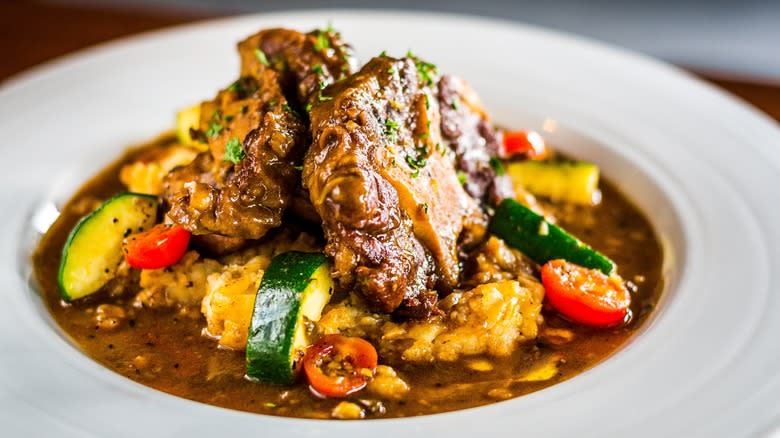
With a name like oxtail, you may be wondering if it is actually a beef cut. But the name is misleading. Historically, oxtail did come from the tail of an ox, but these days, oxtail usually refers to the meat from the cow's tail. It has never been considered a prime steak cut, but was cooked by communities who utilized every part of the animal. However, oxtail has grown in culinary status and popularity, and is typically used in stews or even eaten right off the tailbone. Its texture is somewhat gelatinous thanks to its high collagen content, which people tend to either love or hate.
In terms of health, oxtail doesn't fare better than the other steak cuts on this list, with high concentrations of fat, saturated fat, and cholesterol. When you eat oxtail, the serving is a single tail that tends to weigh somewhere between 7 and 10 ounces. At that size, you're looking at 65% of the daily recommended saturated fat consumption and 74% of the daily recommended cholesterol consumption in one sitting. Oxtail may be a delightful addition to gourmet dishes, but for health reasons, we wouldn't suggest making it a dinner staple.
Methodology

It's no secret that eating too much steak can have negative health consequences. This is primarily because beef, while contributing tons of protein, vitamins, and minerals to our diet, is also high in fat, cholesterol, and calories. In particular, saturated fat and cholesterol can wreak havoc on the body, putting us at risk for heart disease, stroke, cancer, and obesity. That being said, not all cuts of steak have the same nutritional value. They come from separate parts of the cow, which means each can vary widely on how healthy they are for us.
Steak lovers that we are, we researched all the most common cuts of steak to determine which are the unhealthiest of them all. We looked into fat and cholesterol levels in particular, as those factors are big contributors to what makes a cut of steak better or worse for your health. We also considered the typical portion size of a steak because it plays a significant role in how much fat, cholesterol, and calories you consume in a single meal. For example, if the typical serving of a ribeye is 16 ounces, it doesn't make much sense to evaluate the amount of saturated fat you're getting in a 3-ounce serving. Finally, keep in mind that all nutrition facts are estimates, because no two pieces of meat, even of the same cut and size, have the exact same composition.
Read the original article on Mashed.

